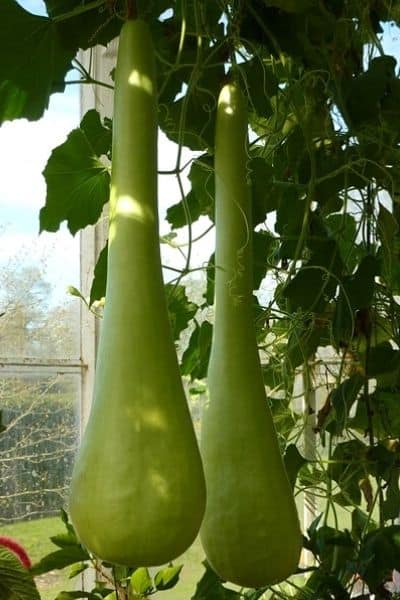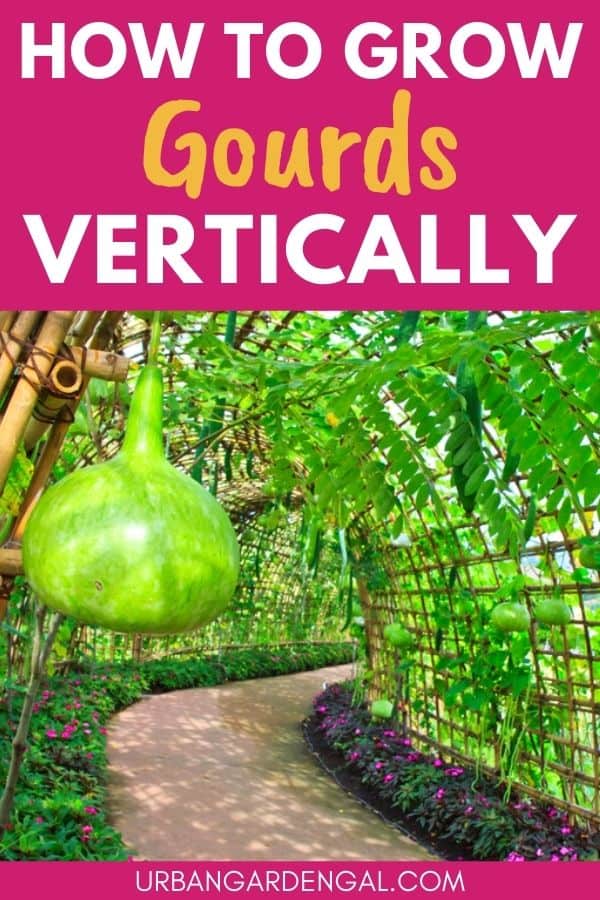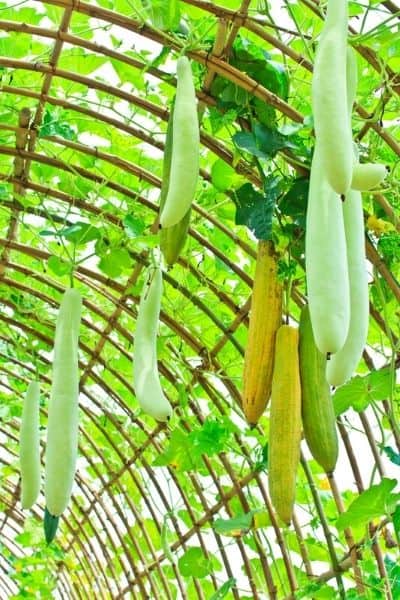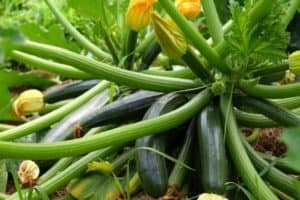Growing gourds vertically
Gourd vines have a vigorous growth habit and take up a lot of space in the garden, so if you have a small garden it’s a good idea to grow gourds vertically.
Gourds can be easily trained to grow up a trellis, fence or pergola and they make an attractive addition to vertical gardens.
In this article I’ll share my tips for growing gourd vines vertically and tell you which gourds are best for vertical gardens.
This post contains affiliate links. Please read the disclosure for more info.

Gourds are part of the cucurbit family that also includes pumpkins and squash.
There are three main types of gourds that you can grow in your garden:
Hard shell gourds (Lagenaria siceraria) last for several years and can be made into bottles, bowls or bird houses.
Ornamental gourds (Cucurbita pepo) come in a variety of shapes, sizes and colors and they’re mostly used for decorations.
Sponge gourds (Luffa cylindrica) can be dried and used as a skin exfoliator or bath sponge.

Support structures for vertical gourds
Gourds need strong, sturdy vertical structures that can support their weight, especially if you’re growing large gourd varieties like birdhouse or bottle gourds.
Arbors, arches and pergolas are perfect for growing gourds vertically and they look attractive with the gourds hanging down.
You can even make a gourd tunnel by bending mesh or bamboo into an arch shape.
If you have a wire fence, you can also train the vines to grow up the fence to give you some extra vertical space in the garden and block out the neighbors!
Advantages of growing gourds vertically
Gourds look great when they’re grown on a trellis or arch with the fruits hanging down and it’s easier to keep the plants healthy when they’re grown up off the ground.
Trellising gourds improves air circulation around the plants, which reduces fungal diseases like powdery mildew and the plants are less likely to be affected by pests when they’re grown vertically.
Long gourds that are trellised grow long and straight rather than curling up on the ground and large round gourds won’t have a flat spot if they’re off the ground.
Gourds that are grown vertically are also much easier to harvest because you have better access the vines.

How to grow gourds vertically
Gourd plants can tolerate light frosts but it’s best to wait until the last frost has passed and the soil has warmed up before planting your seeds.
You can also start the seeds indoors in early spring and transplant them out to the garden when the risk of frost has passed.
Prepare the soil before planting by digging some aged compost into the soil.
Plant the gourd seeds about an inch (2.5 cm) deep close to the trellis or climbing structure you’ve chosen to support the vines.
If you have a small trellis or arch, you’ll probably only need one plant because the vines can grow 16 feet (4.8 metres) or more, depending on the variety.
The seeds should start to sprout in about one to three weeks but it could take longer if the soil is cold.
Gourd plants produce long tendrils that wrap around trellises, fences, pergolas and other vertical structures to help them climb.
As the plants begin to grow, you can train them to grow upwards by wrapping the tendrils around the trellis or wire.
If the plants start to outgrow the trellis you can trim the vines back to fit the space.

Harvesting Gourds
Gourds are usually ready to harvest about 25 weeks after planting.
You can tell when gourds are ready to harvest because the stems will turn brown and the skin of the gourds will be hard.
Always wait until the vines have died back before you begin harvesting gourds.
Cut the stem with a sharp knife, leaving about 2 inches (5 cm) of the stem attached to the gourd.
Take care not to snap the stem off because the gourd won’t cure properly.

Storing Gourds
After you harvest your gourds, wash them in warm, soapy water to get rid of dirt and bacteria that can cause them to rot.
Store the gourds in a cool, dry place like a garage or covered pergola.
Place a piece of cardboard or a pile of newspapers on the floor and then sit the gourds on top, making sure there’s plenty of room for the air to circulate around them.
Check the gourds regularly and discard any that show signs of rotting. [1]
So there are my tips for growing gourds on a trellis, fence or arbor.
Trellising gourds means that it’s possible to grow gourds even if you have limited space in your garden.
RELATED ARTICLES
Have you tried growing gourds vertically? Let me know in the comments below.
Are you on Pinterest? I have boards dedicated to Climbing Plants and Gardening Tips that you may enjoy. You can also find me on Facebook.





